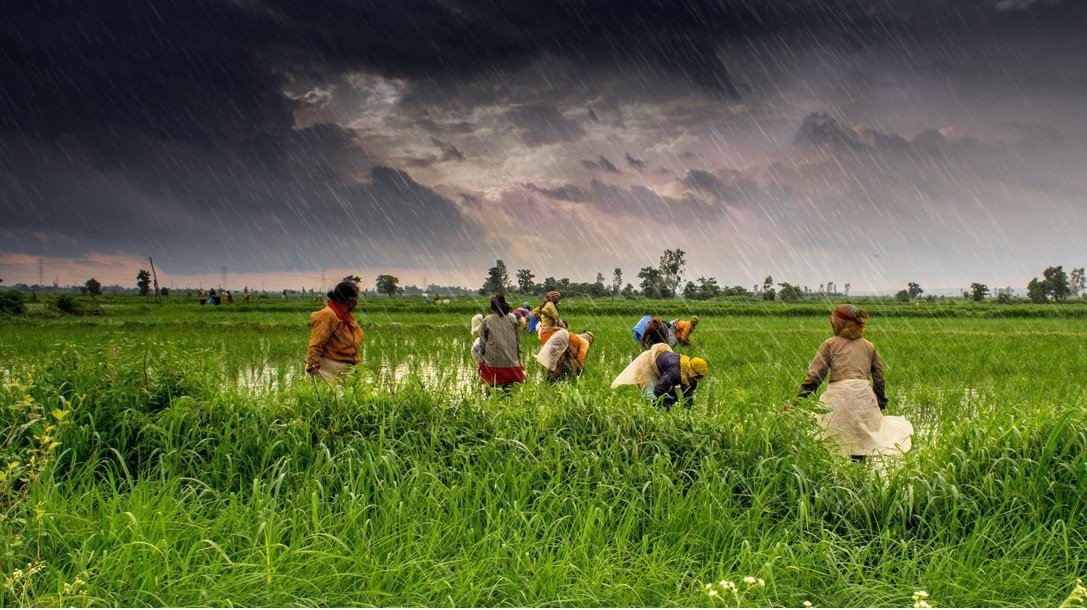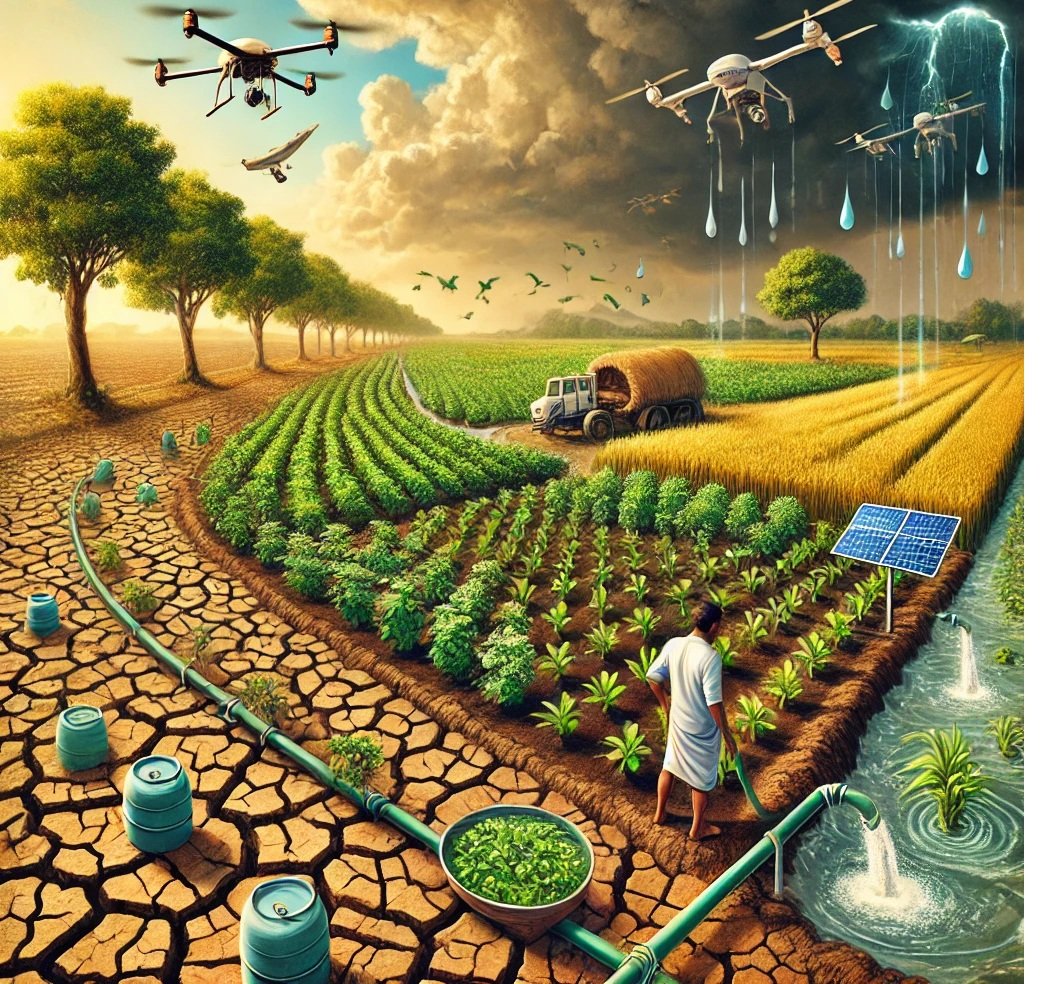Latest News
Impact of Climate Change on Indian Agriculture: Rising Challenges and Sustainable Solutions (2025)

Overview of the Blog
{ Agriculture, a cornerstone of India’s economy, is increasingly vulnerable to climate change. Erratic rainfall patterns, rising temperatures, and extreme weather events are disrupting traditional farming practices and posing severe risks to food security. This blog explores the current state of Indian agriculture, the impact of climate change, government measures, and climate-resilient strategies that can help mitigate these challenges. }
Overview of Indian Agriculture (2025)

The agriculture sector continues to play a pivotal role in India’s economy. Recent trends highlight its performance:
- Growth Rate: 3.5% in the second quarter of FY25.
- Contribution to GDP: Approximately 16% of India’s GDP.
- Workforce: Nearly 46% of India’s population depends on agriculture for their livelihood.
To strengthen this sector, the Indian government has increased the budget allocation:
- Union Budget 2025: ₹1.52 trillion allocated to agriculture and allied sectors, up from ₹1.22 trillion in the previous fiscal year.
Impacts of Climate Change on Indian Agriculture
1. Rising Temperatures and Declining Yields:
Higher temperatures negatively impact crop yields. Research shows that for every 1°C rise in temperature, wheat yields may drop by 4-5%. Rice, maize, and other staples could face similar declines.
- Rainfed rice yields in India may decrease by up to 47% by 2080 without adequate adaptation measures.
- According to the World Economic Forum (2024), India’s agricultural output could decline by 16% by 2030, leading to a 2.8% drop in GDP.
2. Erratic Rainfall Patterns:
The Indian monsoon, which provides nearly 70% of the country’s annual rainfall, has become increasingly unpredictable.
- Delayed or deficient monsoons affect crop cycles and yields.
- Excess rainfall leads to waterlogging, damaging crops like paddy and sugarcane.
- Regional Impacts:
- Unseasonal rains in Punjab and Haryana have lowered wheat production.
- Erratic rainfall in Maharashtra has affected sugarcane and cotton yields.
- Flood-prone states like Bihar and Assam face frequent paddy crop losses due to excessive monsoon rains.

3. Increased Frequency of Extreme Weather Events:
- Droughts reduce water availability for irrigation, affecting crop productivity.
- Cyclones in coastal states such as Odisha, West Bengal, and Andhra Pradesh damage crops and disrupt supply chains.
- Hailstorms and unseasonal rains destroy standing crops, leading to financial losses for farmers.
- Between 2015 and 2021, India lost 33.9 million hectares of crops due to excess rains and an additional 35 million hectares due to drought (World Economic Forum).
4. Soil Degradation and Loss of Fertility:
- Heavy rains and flooding accelerate soil erosion, reducing fertility.
- Rising temperatures increase soil nutrient depletion.
- Coastal areas face increased soil salinity due to rising sea levels.
5. Water Scarcity and Irrigation Challenges:
- Over 50% of India’s agriculture is monsoon-dependent, making it highly vulnerable to erratic rainfall.
- Declining groundwater levels in Punjab, Haryana, and Rajasthan threaten irrigation.
- Excessive groundwater extraction has led to critical depletion in Gujarat, Rajasthan, and Tamil Nadu.
6. Pest and Disease Outbreaks:
Rising temperatures create favorable conditions for pests like the fall armyworm and locusts, which destroy crops. Increased humidity fuels fungal and bacterial diseases in crops such as wheat, rice, and vegetables.
Government Response and Policy Measures
To address these climate challenges, the Indian government has implemented several policy measures:
- National Action Plan on Climate Change (NAPCC): Includes the National Mission for Sustainable Agriculture (NMSA) to promote climate-resilient farming.
- Pradhan Mantri Krishi Sinchayee Yojana (PMKSY): Focuses on improving water efficiency in irrigation.
- Soil Health Card Scheme: Helps farmers monitor soil nutrients and improve fertility.
- Crop Insurance Schemes: Pradhan Mantri Fasal Bima Yojana (PMFBY) provides financial protection against crop losses.
- Promotion of Climate-Resilient Crops: Research institutions are developing drought-resistant and heat-tolerant crop varieties.
- Sub-Mission on Agricultural Extension (SMAE): Disseminates knowledge and promotes sustainable farming practices.
- Weather Forecasting and Early Warning Systems: Enhanced forecasting by the Indian Meteorological Department (IMD) helps farmers plan better.
Climate Proofing Strategies for Agriculture in India
1. Climate-Smart Crop Varieties:
- Developing drought-resistant, flood-resistant, and heat-tolerant crop varieties through institutions like the Indian Council of Agricultural Research (ICAR).
- Promoting traditional and indigenous crop varieties that are naturally resilient.
2. Sustainable Water Management:
- Encouraging micro-irrigation systems (drip and sprinkler irrigation) to improve water efficiency.
- Watershed management and rainwater harvesting to mitigate water stress.
- Promoting the System of Rice Intensification (SRI) to reduce water consumption in paddy cultivation.
3. Agroforestry and Soil Conservation:
- Integrating trees into farmlands to enhance carbon sequestration and soil fertility.
- Practicing zero-tillage farming and cover cropping to maintain soil health.
- Using organic fertilizers and biochar to boost soil resilience.
4. Digital and Technological Interventions:
- Leveraging AI-based weather forecasting and mobile advisory services to help farmers prepare for adverse weather conditions.
- Using drones and sensors for precision farming to optimize resource use.
- Enhancing e-marketing platforms like eNAM to provide better price realization and reduce climate-induced income shocks.
5. Livelihood Diversification and Crop Insurance:
- Promoting integrated farming systems (livestock, fisheries, and horticulture) to reduce dependence on crops.
- Strengthening PMFBY to provide financial security against climate-related crop losses.
6. Policy Support:
- Initiatives like the National Innovations in Climate Resilient Agriculture (NICRA) focus on research, capacity building, and technology dissemination.
Case Studies
- NICRA Villages: Demonstrated climate-proofing techniques in over 446 villages, showcasing the effectiveness of integrated approaches.
- Climate-Smart Farming: Initiatives by organizations like the Environmental Defense Fund have promoted low-carbon farming practices, reducing greenhouse gas emissions while enhancing productivity.
Conclusion
Changing rainfall patterns, rising temperatures, and extreme weather events present significant challenges to Indian agriculture. Urgent action is needed to safeguard farmers’ livelihoods and ensure food security. By adopting climate-resilient practices, improving water management, and strengthening policy support, India can build a sustainable agricultural future. The journey toward climate-proof farming may be challenging, but it is essential for the well-being of millions and the nation’s prosperity.












